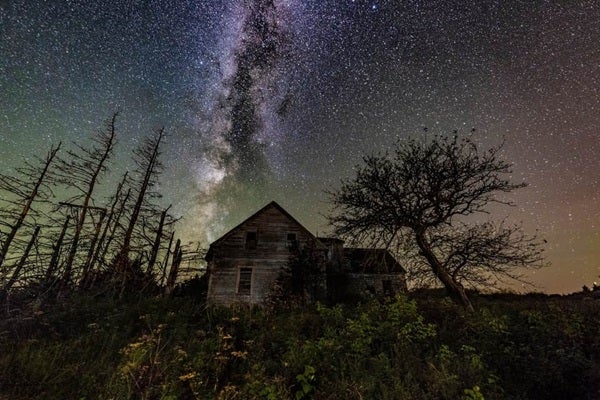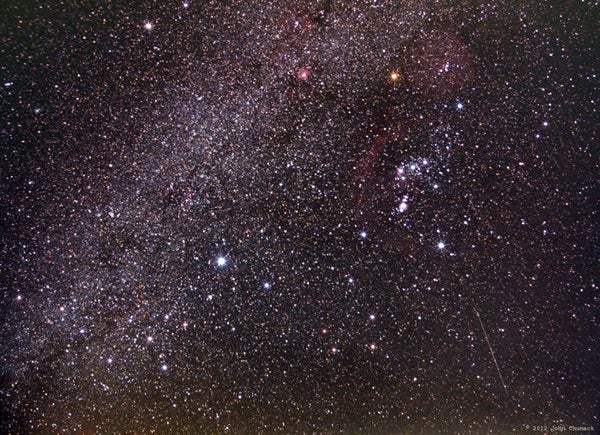Although people in the Northern Hemisphere experienced the shortest day of the year two weeks ago (at the winter solstice December 21), the Sun has continued to rise slightly later with each passing day. That trend stops this morning for those at 40° north latitude. Tomorrow’s sunrise will arrive at the same time as today’s, but the Sun will come up two seconds earlier Sunday morning. This turnover point depends on latitude. If you live farther north, the switch occurred a few days ago; closer to the equator, the change won’t happen until later in January.
Saturday, January 5
New Moon occurs at 8:28 p.m. EST. At its New phase, the Moon crosses the sky with the Sun and so remains hidden in our star’s glare. At least, it typically does. But if you live in the right area, you can watch the Moon pass in front of the Sun and cause a partial solar eclipse. Observers in southwestern Alaska, Japan, and eastern Asia can see the Moon partially eclipse the Sun. Maximum eclipse occurs in eastern Siberia, where our satellite covers 71 percent of the Sun’s disk. Remember that when viewing the Sun during a partial eclipse, protect your eyes by using a safe solar filter.
Sunday, January 6
Venus appears brilliant in the southeast before dawn. It reached greatest elongation late yesterday evening, when it was 47° west of the Sun, so it stands highest in this morning’s sky. The inner world shines at magnitude –4.6, more than 10 times brighter than the second-brightest planet, Jupiter. Venus rises nearly four hours before the Sun and stands 20° high in the southeast when twilight begins. The planet lies among the background stars of Libra, but it will move into Scorpius this coming week. If you point a telescope at Venus, you’ll see a disk that spans 25″ and appears halflit.
On the other end of the planetary spectrum from Venus, at least as far as brightness is concerned, is Neptune. As the sky fully darkens, use binoculars and look toward the southwest to locate the star 81 Aquarii, which glows just below naked-eye visibility at magnitude 6.2. Then look 0.4° to the east to find Neptune. At magnitude 7.9, the eighth planet in our solar system glows nearly two magnitudes fainter than the star. Viewed through a telescope, Neptune’s vivid blue color will reveal it.
Tuesday, January 8
The Moon reaches apogee, the farthest point in its orbit around Earth, at 11 p.m. EDT. It then lies 252,349 miles (406,117 kilometers) from Earth’s center.
Wednesday, January 9
The Moon sets several hours after darkness falls, so after it does, if your site is dark enough, look for the faint band of the Milky Way stretching from the southeast to the northwest before moonrise. This evanescent glow marks the spiral arms of our galaxy. Our star system — also named the Milky Way — would appear as a pinwheel with a central hub (containing 90 percent of the stars) from which stellar arms curve around it. Early skywatchers thought this band looked like milk. The Romans called it the via lactea and had a myth that told how a hungry infant Mars wrenched his brother Vulcan away from their mother Juno as she was nursing the latter god, spilling milk across the sky. Italian astronomer Galileo Galilei was the first to discern the true nature of the Milky Way through one of his early telescopes. Today, astronomers know it’s billions of stars too far away for us to see individually without optical aid.
Thursday, January 10
Mars lies in the constellation Pisces the Fish near that constellation’s border with another watery figure, Cetus the Whale. The Red Planet has faded since last year’s brilliance, but still glows with a magnitude of 0.6, much brighter than any of the stars that surround it. Unfortunately, this is the best Mars will look this year. It will continue to fade in brightness and won’t be this bright again until April 2020.
Have you ever seen the constellation Leo Minor the Lion Cub? If you answered, “No,” tonight could be your night. You can look for it around midnight local time. Don’t try before that because the Moon will still be in the sky. Unfortunately, Leo Minor is so faint that you’ll have to find two other celestial signposts — the Big Dipper and Leo the Lion — and work from them. The Big Dipper will lie high in the northeast and Leo low in the east. Draw a 45°-long line from Merak (Beta [β] Ursae Majoris), which is the Dipper’s Pointer star at the bottom of the cup, to Regulus (Alpha [α] Leonis), Leo’s brightest star. Leo Minor lies at the exact midpoint of that line. When you do locate its position, you might question the imaginations of early stargazers who drew a lion cub out of these faint stars. The constellation’s brightest star is 46 Leonis Minoris, which shines at magnitude 3.8. (The constellation doesn’t have a star labeled Alpha.) Beta Leonis Minoris is a bit fainter at magnitude 4.2.
Saturday, January 12
The variable star Algol in Perseus reaches minimum brightness this morning at 2:11 a.m. EDT. If you start watching the star a few hours after the sky darkens Friday evening, you can see Algol dim by 70 percent over the course of about 5 hours. (Astronomers would say its brightness drops from magnitude 2.1 to 3.4.) This eclipsing binary runs through a cycle from minimum to maximum and back every 2.87 days. Algol stands one-third of the way up in the northwest and sets about an hour after it reaches minimum brightness.
Sunday, January 13
The Winter Triangle shines in the southeast as darkness falls. This triplet of stars is an example of an asterism — a recognizable star pattern that’s not one of the official constellations. The most famous asterism is the Big Dipper, seven bright stars within the constellation Ursa Major the Great Bear. But asterisms also can incorporate stars from different constellations. The Winter Triangle, for example, uses the brightest stars from three of this season’s heavenly figures. The brightest of the three luminaries — and, indeed, the brightest of all the nighttime stars — is Sirius, which marks the head (or perhaps a jewel on the collar) of Canis Major the Great Dog. To Sirius’ upper left is Procyon, the sky’s eighth-brightest star and number one in Canis Minor the Small Dog. And at the westernmost tip of the Winter Triangle lies copper-hued Betelgeuse, the sky’s 10th-brightest star and the one marking the right shoulder of Orion the Hunter.












